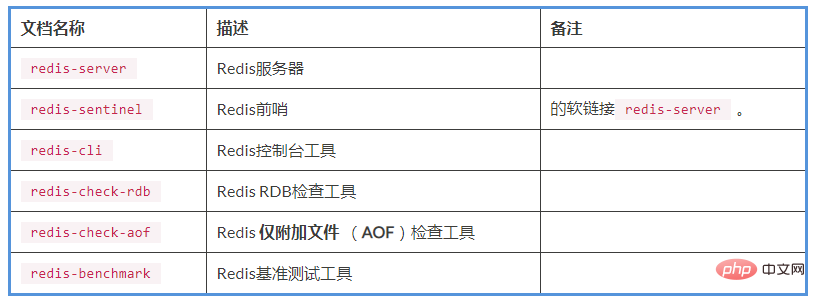Redis download and install
The following column Redis Tutorial will introduce you to the specific steps of Redis download and Redis installation. I hope it will be helpful to friends in need!

Redis Download and Install
Redis has an active community on GitHub. Over the years, a large number of pull requests have been raised and merged, and the author Antirez always provides timely responses in the issues section of GitHub. Therefore, the release cycle of Redis is very fast. They are widely used from the early versions 2.6/2.8 to 3.0/3.2 to the latest 4 versions. Each version provides some basic enhancements and bugfixes. Therefore, it is one of the best practices to use the latest version of Redis if possible.
In this book, we use the latest version of Redis 4.0.1.
Redis is an open software written in pure C language, so we can install it by compiling. Major operating systems also include Redis binary packages in their software repositories, although the Redis versions are often out of date.
1: Prepare!
You can find the download link and basic installation steps at https://redis.io/download. If you want to build Redis by compiling source code in Linux/Unix/macOS, you need the gcc compiler and the C standard library libc in your environment. When installing the OS repository, all you need is an Internet connection and the correct repository configuration.
2: How to do it?
We will demonstrate the compilation and installation of Redis in Ubuntu 16.04.2 LTS (Xenial Xerus). The download and build steps are as follows:
Set up the build tool:
$ sudo apt-get install build-essential
Create a directory and enter Redis:
$ mkdir /redis $ cd /redis
Then, download Redis:
$ wget http://download.redis.io/releases/redis-4.0.1.tar.gz
Solution Zip and enter the directory:
$ tar zxvf redis-4.0.1.tar.gz $ cd redis-4.0.1
Create a directory for the Redis configuration file and copy the default configuration file into it:
$ mkdir /redis/conf $ cp redis.conf /redis/conf/
Establish dependencies:
$ cd deps $ make hiredis lua jemalloc linenoise $ cd ..
Note
Due to differences between the various operating systems and libraries installed on them, the above steps will be required when an error occurs indicating that something is not met. For example, you may encounter the error message: zmalloc.h:50:31: fatal error: jemalloc/jemalloc.h: No such file or directory. For most environments, this step is not necessary if there are no issues with the dependencies in question. .
Compiling:
$ make
If all goes well, the following message will be displayed. This means that the compilation was completed successfully:
It's a good idea to run 'make test' ;) make[1]: Leaving directory '/redis/redis-4.0.1/src'
Installing Redis:
$ make PREFIX=/redis install
The following message means that the installation was successful:

Enter the /redis directory and verify that the Redis binary has been generated:
$ ls /redis/bin redis-benchmark redis-check-aof redis-check-rdb redis-cli redis-sentinel redis-server
Congratulations! You have completed the compilation and installation of Redis.
Compared with compiling and installing, apt-get is much easier to install Redis in Ubuntu. Let’s take a look:
First, update the software repository index:
$ sudo apt-get update
Then start the installation:
$ sudo apt-get install redis-server
Once completed, check if Redis is set up in your environment :
$ which redis-server
Three: How does this work?
When choosing a Redis version, remember that Redis follows standard versioning conventions, which is the major.minor.patch level. Even-numbered minors represent stable versions, while odd-numbered minors represent unstable versions, although some versions of Redis use odd-numbered minors.
The difference between building Redis by compiling and building from a software repository is that the former can add optimization or debugging options at compile time and also has the flexibility to specify the installation location during the installation process.
After installation, there are some executable files in the bin directory. Their descriptions and instructions are shown in the table below:

Four: And more!
For Windows, you can get the Redis version for Windows, which is maintained by the Microsoft Open Technologies group:
https://github.com/MicrosoftArchive/redis/releases .
Simply download the .msi executable file and double-click to install, keeping the default configuration.
For macOS, the process is not much different than in Linux. You can also install Redis by issuing the brew install redis command on macOS.
The above is the detailed content of Redis download and install. For more information, please follow other related articles on the PHP Chinese website!

Hot AI Tools

Undresser.AI Undress
AI-powered app for creating realistic nude photos

AI Clothes Remover
Online AI tool for removing clothes from photos.

Undress AI Tool
Undress images for free

Clothoff.io
AI clothes remover

Video Face Swap
Swap faces in any video effortlessly with our completely free AI face swap tool!

Hot Article

Hot Tools

Notepad++7.3.1
Easy-to-use and free code editor

SublimeText3 Chinese version
Chinese version, very easy to use

Zend Studio 13.0.1
Powerful PHP integrated development environment

Dreamweaver CS6
Visual web development tools

SublimeText3 Mac version
God-level code editing software (SublimeText3)

Hot Topics
 How to build the redis cluster mode
Apr 10, 2025 pm 10:15 PM
How to build the redis cluster mode
Apr 10, 2025 pm 10:15 PM
Redis cluster mode deploys Redis instances to multiple servers through sharding, improving scalability and availability. The construction steps are as follows: Create odd Redis instances with different ports; Create 3 sentinel instances, monitor Redis instances and failover; configure sentinel configuration files, add monitoring Redis instance information and failover settings; configure Redis instance configuration files, enable cluster mode and specify the cluster information file path; create nodes.conf file, containing information of each Redis instance; start the cluster, execute the create command to create a cluster and specify the number of replicas; log in to the cluster to execute the CLUSTER INFO command to verify the cluster status; make
 How to read redis queue
Apr 10, 2025 pm 10:12 PM
How to read redis queue
Apr 10, 2025 pm 10:12 PM
To read a queue from Redis, you need to get the queue name, read the elements using the LPOP command, and process the empty queue. The specific steps are as follows: Get the queue name: name it with the prefix of "queue:" such as "queue:my-queue". Use the LPOP command: Eject the element from the head of the queue and return its value, such as LPOP queue:my-queue. Processing empty queues: If the queue is empty, LPOP returns nil, and you can check whether the queue exists before reading the element.
 How to clear redis data
Apr 10, 2025 pm 10:06 PM
How to clear redis data
Apr 10, 2025 pm 10:06 PM
How to clear Redis data: Use the FLUSHALL command to clear all key values. Use the FLUSHDB command to clear the key value of the currently selected database. Use SELECT to switch databases, and then use FLUSHDB to clear multiple databases. Use the DEL command to delete a specific key. Use the redis-cli tool to clear the data.
 How to configure Lua script execution time in centos redis
Apr 14, 2025 pm 02:12 PM
How to configure Lua script execution time in centos redis
Apr 14, 2025 pm 02:12 PM
On CentOS systems, you can limit the execution time of Lua scripts by modifying Redis configuration files or using Redis commands to prevent malicious scripts from consuming too much resources. Method 1: Modify the Redis configuration file and locate the Redis configuration file: The Redis configuration file is usually located in /etc/redis/redis.conf. Edit configuration file: Open the configuration file using a text editor (such as vi or nano): sudovi/etc/redis/redis.conf Set the Lua script execution time limit: Add or modify the following lines in the configuration file to set the maximum execution time of the Lua script (unit: milliseconds)
 How to set the redis expiration policy
Apr 10, 2025 pm 10:03 PM
How to set the redis expiration policy
Apr 10, 2025 pm 10:03 PM
There are two types of Redis data expiration strategies: periodic deletion: periodic scan to delete the expired key, which can be set through expired-time-cap-remove-count and expired-time-cap-remove-delay parameters. Lazy Deletion: Check for deletion expired keys only when keys are read or written. They can be set through lazyfree-lazy-eviction, lazyfree-lazy-expire, lazyfree-lazy-user-del parameters.
 How to use the redis command line
Apr 10, 2025 pm 10:18 PM
How to use the redis command line
Apr 10, 2025 pm 10:18 PM
Use the Redis command line tool (redis-cli) to manage and operate Redis through the following steps: Connect to the server, specify the address and port. Send commands to the server using the command name and parameters. Use the HELP command to view help information for a specific command. Use the QUIT command to exit the command line tool.
 How to implement redis counter
Apr 10, 2025 pm 10:21 PM
How to implement redis counter
Apr 10, 2025 pm 10:21 PM
Redis counter is a mechanism that uses Redis key-value pair storage to implement counting operations, including the following steps: creating counter keys, increasing counts, decreasing counts, resetting counts, and obtaining counts. The advantages of Redis counters include fast speed, high concurrency, durability and simplicity and ease of use. It can be used in scenarios such as user access counting, real-time metric tracking, game scores and rankings, and order processing counting.
 How to optimize the performance of debian readdir
Apr 13, 2025 am 08:48 AM
How to optimize the performance of debian readdir
Apr 13, 2025 am 08:48 AM
In Debian systems, readdir system calls are used to read directory contents. If its performance is not good, try the following optimization strategy: Simplify the number of directory files: Split large directories into multiple small directories as much as possible, reducing the number of items processed per readdir call. Enable directory content caching: build a cache mechanism, update the cache regularly or when directory content changes, and reduce frequent calls to readdir. Memory caches (such as Memcached or Redis) or local caches (such as files or databases) can be considered. Adopt efficient data structure: If you implement directory traversal by yourself, select more efficient data structures (such as hash tables instead of linear search) to store and access directory information






